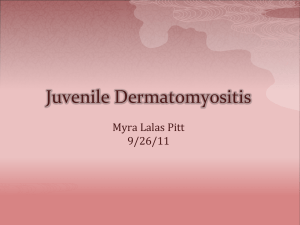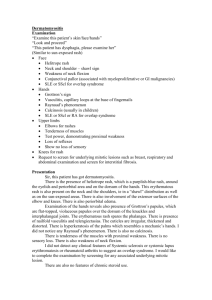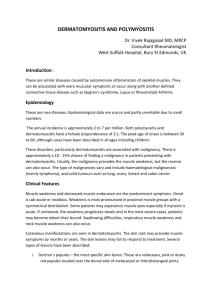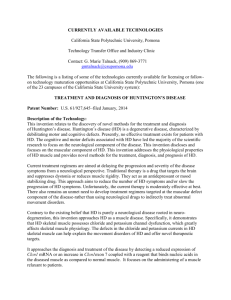Quick Diagnosis : Dermatomyositis Jonathan M S Levy, MD
advertisement
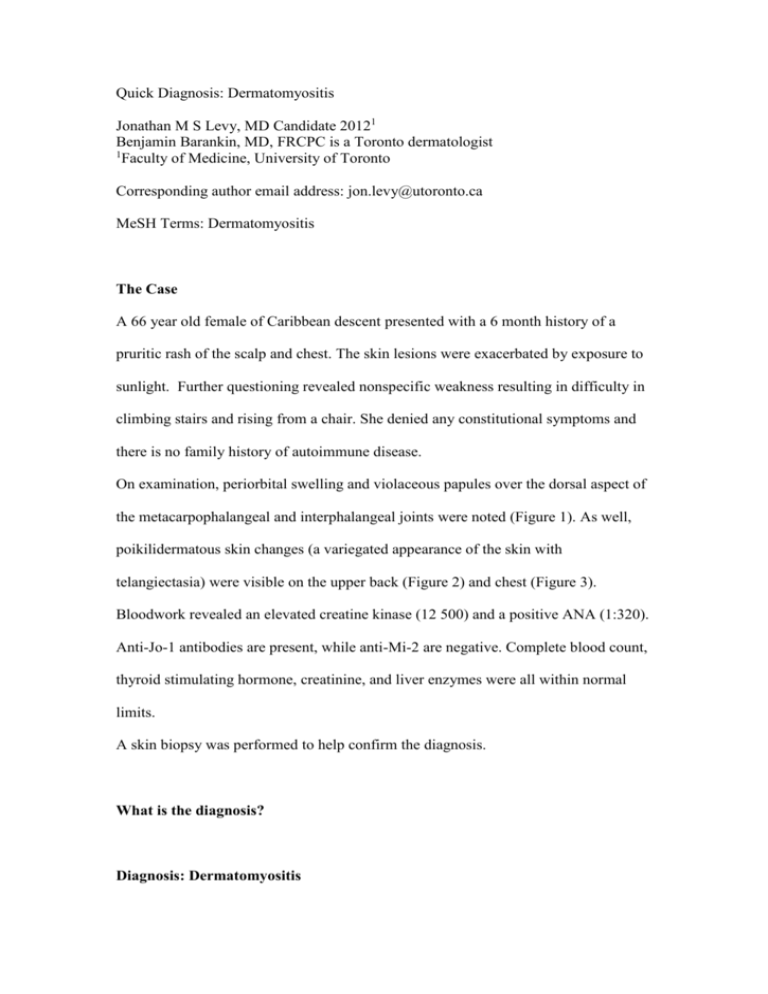
Quick Diagnosis: Dermatomyositis Jonathan M S Levy, MD Candidate 20121 Benjamin Barankin, MD, FRCPC is a Toronto dermatologist 1 Faculty of Medicine, University of Toronto Corresponding author email address: jon.levy@utoronto.ca MeSH Terms: Dermatomyositis The Case A 66 year old female of Caribbean descent presented with a 6 month history of a pruritic rash of the scalp and chest. The skin lesions were exacerbated by exposure to sunlight. Further questioning revealed nonspecific weakness resulting in difficulty in climbing stairs and rising from a chair. She denied any constitutional symptoms and there is no family history of autoimmune disease. On examination, periorbital swelling and violaceous papules over the dorsal aspect of the metacarpophalangeal and interphalangeal joints were noted (Figure 1). As well, poikilidermatous skin changes (a variegated appearance of the skin with telangiectasia) were visible on the upper back (Figure 2) and chest (Figure 3). Bloodwork revealed an elevated creatine kinase (12 500) and a positive ANA (1:320). Anti-Jo-1 antibodies are present, while anti-Mi-2 are negative. Complete blood count, thyroid stimulating hormone, creatinine, and liver enzymes were all within normal limits. A skin biopsy was performed to help confirm the diagnosis. What is the diagnosis? Diagnosis: Dermatomyositis Clinical Presentation Dermatomyositis (DM) is an autoimmune idiopathic inflammatory myopathy with characteristic cutaneous findings such as a heliotrope rash and Gottron papules, as well as proximal muscle weakness. There is an increased risk of malignancy in individuals over 55 years of age.1 Five criteria are used in establishing a diagnosis of DM: progressive proximal symmetrical weakness, elevated muscle enzymes, characteristic findings on electromyograms, on muscle biopsy, and compatible cutaneous disease.2 DM is relatively rare with an incidence of 6 cases per million. Age of onset follows a bimodal distribution with juvenile and adult (>40 years) peaks. Incidence is almost twice as common in women as men.3 Dermatologists and rheumatologists, and less commonly neurologists, are typically involved in the care of DM patients. Juvenile DM is often associated with vasculitis and calcinosis; interstitial pneumonitis, cardiomyopathy, and arthritis are particularly common in juvenile DM as well. Meanwhile, adult-onset DM may be associated with an internal malignancy, especially ovarian cancer in women.4 Malignancy evaluations are thus recommended for any patient with DM. Examination for an occult malignancy in otherwise asymptomatic patients should be age-specific, or directed by symptoms and/or findings on physical examination or laboratory tests.5 The clinical spectrum ranges from amyopathic DM, with only cutaneous symptoms, to polymyositis, which only involves muscle inflammation. Various histopathologic features are compatible with DM, but are not pathognomonic; these include: flattening of the epidermis, hydropic degeneration of basal cell layer, edema of upper dermis, scattered inflammatory infiltrate, PAS-positive fibrinoid deposits at dermal-epidermal junction and around upper dermal capillaries, and accumulation of acid mucopolysaccharides in the dermis.6 Muscle inflammation is confirmed with a deep muscle biopsy, usually of a weak or tender shoulder or pelvic girdle muscle, by a surgeon. The biopsy histologically shows segmental necrosis within muscle fibres with the presence of inflammatory cells including histiocytes, macrophages, lymphocytes, and plasma cells.6 While the etiology of DM and autoimmune disease in general are unknown, several factors may be involved, including certain HLA types, polymorphisms in tumour necrosis factor, abnormal T-cell activity, circulating autoantibodies, certain viruses, and medications. The appearance of skin disease may precede myositis or vice versa; alternatively, both may concurrently appear. Muscle involvement manifests as a progressive muscle weakness affecting proximal and limb girdle muscles, with or without muscle tenderness and atrophy. Patients often have difficulty rising from a sitting or supine position without using arms, raising their arms above their head (e.g. to comb their hair), and in climbing stairs. Involvement of intercostals muscles may result in difficulty breathing. Infrequently, facial/bulbar, pharyngeal, and esophageal muscles may be affected, resulting in dysphagia. Deep tendon reflexes remain intact. The main, unique skin finding is a periorbital heliotrope (violaceous-purple) rash, often accompanied with edema. This may extend to involve the scalp (with non-scarring alopecia) resulting in burning and pruritus, as well as the entire face, upper chest and arms.6 Papular dermatitis with violaceous erythema may present in the same areas. Gottron papules (flat-topped, violaceous papules) may appear on the back of the neck and shoulders, over the metacarpophalangeal and interphalangeal joints, and less often the knees and elbows. Periungual erythema with telangiectasia may be noted. Longlasting lesions on exposed skin may evolve into poikiloderma, which often distributes in a V-pattern over the upper chest and back and anterior neck (shawl sign). While patients do not complain of photosensitivity, the outbreak of dermatomyositis is photodistributed and photoexacerbated, with the exception of heliotrope rash. Infrequent skin manifestations include vesiculobullous, erosive lesions, and an exfoliative erythroderma. Differential Diagnosis The differential diagnosis of DM includes seborrheic dermatitis, lupus erythematosus, mixed connective tissue disease, steroid myopathy, allergic contact dermatitis, pityriasis rubra pilaris, polymorphous light eruption, and lichen planus. Gottron papules affect the skin overlying the joints in DM, as opposed to lupus erythematosus in which lesions occur in the interarticular region of the fingers, sparing the skin overlying the joints. Diagnosis During the active acute phase muscle enzyme levels should be obtained, including creatine phosphokinase, which is most specific for muscle disease. Other tests of possible assistance include aldolase and lactate dehydrogenase. The autoantibodies antinuclear antibody (ANA), anti-Mi-2, and anti-Jo-1 are important tests to help confirm the diagnosis. Workup may also include electromyography and MRI of the affected muscle. Diagnosis of DM may be confirmed by the combination of characteristic skin signs, proximal muscle weakness, elevated serum muscle enzyme levels, characteristic electromyographic changes, and diagnostic muscle biopsy.2 Electrocardiogram is useful in detecting an associated myocarditis, atrial or ventricular irritability, and/or atrioventricular block. Chest x-ray is recommended to recognize interstitial fibrosis.6 Reduced peristalsis, due to myositis, can be diagnosed with an esophageal x-ray. Prognosis Prognosis of DM is guarded, but with treatment prognosis becomes relatively good, with the exception of patients with underlying malignancy or pulmonary involvement. Aggressive immunosuppressive treatment improves survival rate dramatically. Mortality rates in children are below 10% with the early and aggressive use of glucocorticoids,6 although there is significant morbidity in the subset of patients with calcinosis cutis. The most common causes of death in DM are malignancy, infection, cardiac or pulmonary disease. Dramatic improvement of DM often occurs as a result of treatment of an associated neoplasm. Treatment Myositis is treated using prednisone with or without immunosuppressive agents. Skin manifestations are managed by avoiding sun exposure and by using sunscreens, topical corticosteroids or topical calcineurin inhibitors, antimalarial agents, and/or methotrexate or mycophenolate mofetil. High-dose IV immunoglobulin therapy is useful for patients with recalcitrant DM to achieve or maintain remissions.7 Rituximab, an anti-CD20 antibody specific in targeting B cells, has shown benefit,8 but more research is needed. Back to the Case The patient was diagnosed with dermatomyositis on clinical grounds coupled with laboratory evidence and histopathology. In consultation with rheumatology, she was started on a tapering dose of prednisone at 50mg orally once daily for 4 weeks. As well, methotrexate 15mg orally once weekly and folic acid 5mg orally once daily (except on day of methotrexate) was initiated for long-term immunosuppressive control. Betamethasone valerate 0.1% cream was to be applied to affected skin areas twice daily. Sun avoidance and sun protective measures, such as broad-spectrum sunscreens, were encouraged. A CT scan of the abdomen and pelvis did not reveal any signs of ovarian or other underlying malignancy. At 2 months follow-up, the skin lesions were fading and by 6 months her subjective proximal muscle weakness had significantly improved and her skin greatly improved with only post-inflammatory hyperpigmentation remaining. Acknowledgments None Conflicts of Interest None Supporting Information N/A References 1.Airio A, Pukkala E, Isomaki H. Elevated cancer incidence in patients with dermatomyositis: a population based study. J Rheumatol. 1995 Jul;22:1300–3. 2. Bohan A, Peter JB. Polymyositis and dermatomyositis (first of two parts). N Engl J Med. 1975 Feb;292(7):344-7. 3. Drake LA, Dinehart SM, Farmer ER, Goltz RW, Graham GF, Hordinsky MK, Lewis CW, Pariser DM, Skouge JW, Webster SB, Whitaker DC, Butler B, Lowery BJ, Sontheimer RD, Callen JP, Camisa C, Provost TT, Tuffanelli DL. Guidelines of care for dermatomyositis. American Academy of Dermatology. J Am AcadDermatol. 1996 May;34(5 pt 1):824–9. 4. Whitmore SE, Rosenshein NB, Provost TT. Ovarian cancer in patients with dermatomyositis. Medicine (Baltimore). 1994 May;73(3):153-60. 5. Callen, JP. Relationship of Cancer to inflammatory muscle diseases. Dermatomyositis, polymyositis, and inclusion body myositis. Rheum Dis Clin North Am. 1994 Nov;20(4):943-53. 6. Wolff K, Johnson RA. Fitzpatrick's Color Atlas & Synopsis of Clinical Dermatology. 6th ed. New York: McGraw-Hill; 2009. 370-3 p. 7. Dalakas MC, Illa I, Dambrosia JM, et al. A controlled trial of high-dose intravenous immune globulin infusions as treatment for dermatomyositis. N Engl J Med. 1993 Dec;329(27):1993-2000. 8. Chung L, Genovese MC, Fiorentino DF. A pilot trial of rituximab in the treatment of patients with dermatomyositis. Arch Dermatol. 2007 Jun;143(6):763-7. Figures and Figure Captions Figure 1: Gottron Papules: Violaceous, flat-topped papules are seen over the dorsal aspect of the metacarpophalangeal andinterphalangeal joints. Figure 2: Shawl sign: Poikiloderma skin changes on the upper back Figure 3: Poikiloderma distributed in a V-sign over the anterior neck.
